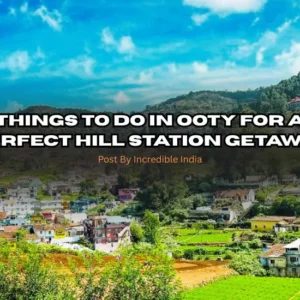Dooars is an alluvial floodplain in Eastern- North-Eastern India. The expansion of the area is about thirty kilometers in width and three hundred fifty kilometers in length. The area covers around the Teesta River of West Bengal to the Dhansiri River in Assam. Situated in the foothills of Himalayas Dooars, it is an important part of ‘Incredible India‘.
Elevation and Boundary:
The surface elevation of Dooars is 300ft to 5,740ft. Brahmaputra and Murti are the predominant rivers here. The actual meaning of Dooars is ‘Doors’ in Assamese, Bengali, Maithili, Bhojpuri, and Magahi languages. The western portion of Dooars is known as Bengal Dooars and the eastern portion is known as Assam Dooars. Terai in Northern India and southern Nepal is analogous to it.
History of Dooars:
Under the Koch Dynasty, the Dooars belonged to the Kamata Kingdom. Due to the weakness of the Koch Kingdom, Bhutan took possession of Dooars. In 1865 the British annexed it after the Bhutan War. The area was divided into two parts. One part mingled with Goalpara District and another part formed a new district named Western Dooars. In the year of 1869, the area was renamed Jalpaiguri district. After the Independence of India, it acceded to the dominion of India, and afterward, in 1949 it merges with independent India.
Geography and Climate:
The plains of Darjeeling District, the total Jalpaiguri District, and the upper regions of Cooch Bihar in West Bengal and also some districts of Assam are consisting in this region. The average rainfall in this area is about 3500mm. The monsoon begins from mid-May until the end of September. Foggy and cold winters are there followed by a mild summer.
Forests and Animals:
The tea estates and the dense forests are the main attraction of Dooars. Wildlife Sanctuaries like Manas National Park etc are in Assam. In West Bengal JaldaparaJaldapara National Park, Buxa Tiger Reserve, and Gorumara National Park are some important wildlife sanctuaries.
Some endangered species of animal-like single-horned rhinos are the residents of this forest. Bengal Tiger, Sloth Bear, Grey Langoor, Indian Cobra, etc are some important animals that can be seen here. In lakes, some ancient birds can be found and in the case of predatory birds vultures and Eagles are predominant. The Hispid Hare is a very rear animal that resides here.
The Economy of Dooars:
Tea, tourism, and timber are the three ‘T’s which are the backbone of the economy of Dooars. The local people are mainly engaged in the tea garden and the cultivation of beetle nuts. As Dooars is dotted with several sanctuaries and forests, tourism is another pillar of the economy. The timber industry is famous here. As it is the doorway of Bhutan, the timber industry has flourished here.
Local life and Culture:
The people of Dooars mainly have the Mongolian structure and they are comprised of several tribes like Bodo, Rava, Mech, Toto, etc. As Dooars was under the Coch Kingdom years ago, several Rajbanshis and Kamtapuri people are residing here.
How to Reach:
The gateway of Dooars is Siliguri. To reach Dooars from Delhi or Kolkata, the nearest airport is Bagdogra. A broad-gauge railway service connecting Dooars from Cooch Bihar with Kolkata and New Jalpaiguri railway stations. The long-distance bus route service is available through NBSTC from Kolkata, Siliguri, New Jalpaiguri, and all the places in the state of West Bengal.
Specialty:
It is mainly famous for its tea estates and wildlife sanctuaries. In the sanctuaries, one can see herds of deer, one-horned rhinos, elephants, gaurs, and reptiles.
The Places to Visit:
For a nature lover, Dooars is nothing but a Paradise. The name Dooars is given as it is the doorstep of Bhutan and North East India. The dense Forest and exotic lifestyle of the wild animals blessed this region. Rich flora and faunas are behind the serene beauty of this place in our ‘Incredible India‘.
Chapramari Wildlife Sanctuary:
Driving through some exotic tea estates, the sanctuary will come in front of you. Chapra means fish and Mari means plenty. The region is famous for its elephants, gaurs which are commonly found here, and also the Royal Bengal Tigers.
Buxa Tiger Reserve:
Buxa Tiger Reserve has a fantastic location that includes River Jayanti, mountains, and dense forests. It is situated in Alipurduar. The area of the forest is nearly 760 sq km with a mixture of different types of wild vegetation. It is an absolute delight for the bird watchers. Other attractions here are the famous Buxa Fort, Jayanti, and Tajabhatkhawa.
Rasikbil Bird Sanctuary:
It is a paradise if the bird watchers. It is a low water land consisting of other four water bodies. Different types of birds can be seen here through binoculars. Boating and occasional walking to the forest are the other options available here.
Gorumara National Park:
It is one of the most popular destinations of Dooars by the side of rivers Murty and Raidak. It is specifically known for being home to the great Indian one-horned Rhinoceros. Elephant, Leopard, Hornbill, etc. are the other wild species available here.
Jaldapara National Park:
This sanctuary was established in 1941. It is a riverine forest with tall grass. Along with one-horned Rhinoceros, other wild animals are seen here. Elephant and Jeep safaris are the other attractions here.
Time Duration:
To visit the place properly will take three to four days. Don’t forget to bring the handicrafts of the people here.
Where to Stay and Car Rental:
Different types of hotels and forest bungalows are available through booking. All are neat and clean at an affordable price.
Jeeps are there for you on the safari. Exotic journeys are done by skilled hands who have acted as guides also. The cultural programs are a must-see during the tour.
Dooars, in West Bengal, occupy an important place in our ‘Incredible India‘. Go and have the essence of it. The tour must be remembered by you all through. Have a nice trip.



